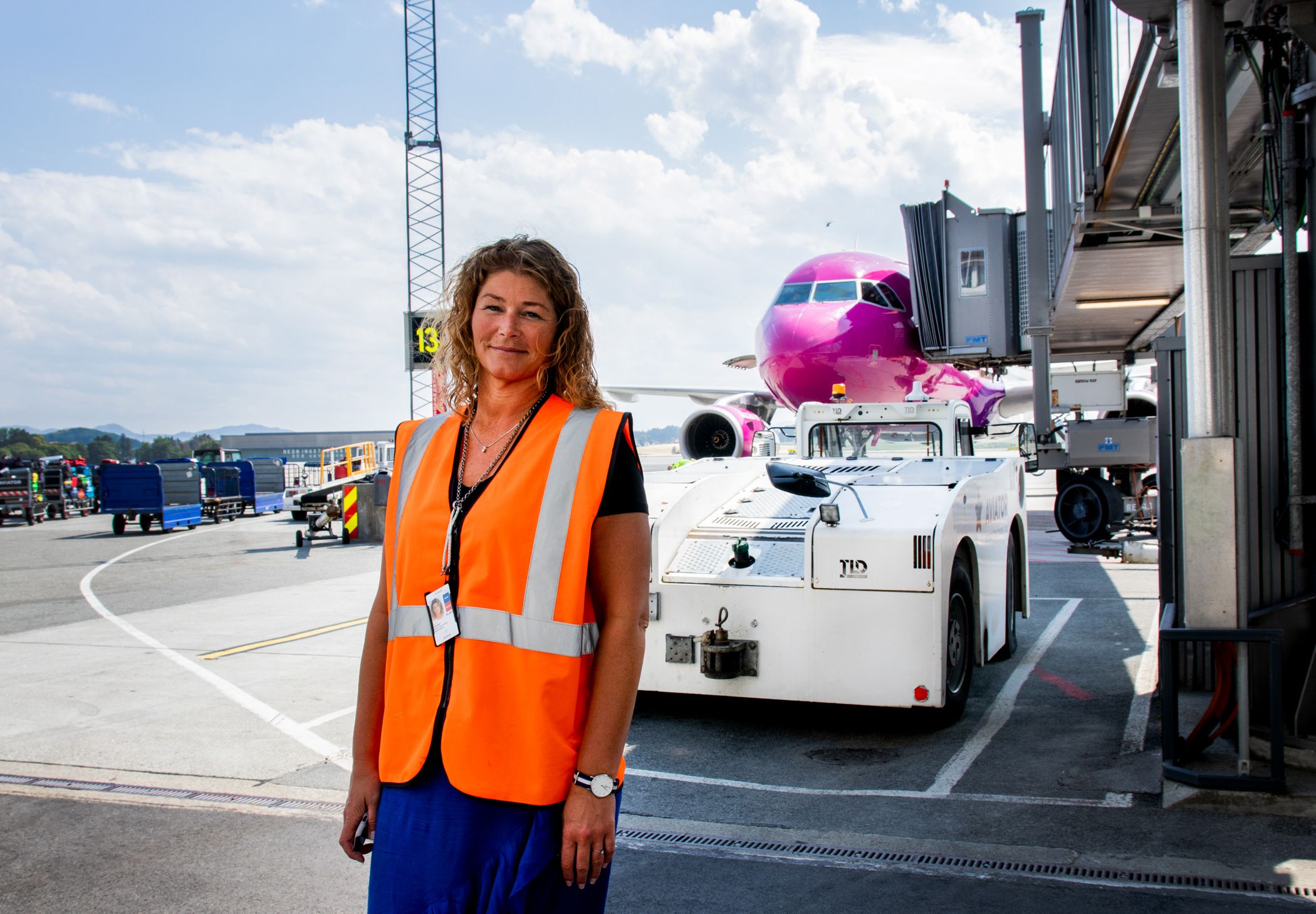Electric aircraft – a reality earlier than expected
Airports are preparing for electric aircraft. Technology and safety experts believe that we will see electric aircraft earlier than previously thought.
“It’s a bit noisy, so you need to cover your ears,” says Anette Sigmundstad Heggen, Safety and Quality Manager at Stavanger Airport Sola.
She is standing on the tarmac below gate 13, whereto a passenger plane has just been taxied.
“In the future, gates will be designed to accommodate charging electric aircraft, she explains.”

“In the future, the gates will also be designed to charge electric aircraft,” explains Anette Sigmundstad Heggen, Safety and Quality Manager at Stavanger Airport Sola. Photo: Didrik Skodje
Infrastructure
In the United States, Jet Suite has ordered 100 electric aircraft from Zunum Aero. The aircraft will have between 6 and 12 seats, and according to the manufacturer they will be delivered in the early 2020s. We can reasonably expect similar airplanes on Norwegian domestic routes within seven years.
“It’s technically feasible already today. But with certification, regulations and infrastructure, we will probably see this around 2025. We simply need to jump on board. Things happen quickly,” Heggen says.
Electric aircraft are under development, but the infrastructure at the airports also needs to be in place. Work is already under way, and Director of Business Development at Siemens, Tor Krog, believes it is likely that everything will be ready before originally planned.
“All predictions say that things will happen faster than we think. I wouldn’t be surprised if electric aircraft become a reality sooner rather than later,” Krog says.
Greater power requirements
Our electric future will require far greater power supply than airports can offer today. Aircraft are not the only vehicles to be electrified. Airports will also need power for buses, cars and taxi bots, to name a few such vehicles.
Today, the approximate turnaround time for aircraft is 20 minutes, i.e. the time between disembarking and boarding. When many aircraft arrive simultaneously, this will lead to consumption power peaks that the airports must be able to cope with.
“You get a huge power demand, which we need to even out. We must have solutions for smart energy storage to realise this. For example, we can use batteries to store energy at the airport,” explains Krog.

Director of Business Development in Siemens, Tor Didrik Krog, believes electric aircraft can become a reality earlier than previously proposed. Photo: Didrik Skodje
“We have co-started a project with Forus Næringspark, Risavika Havn, Lyse AS and Lyse Elnett to look at the possibility of creating MicroGrid and to develop both production and power supply jointly,” says Heggen.
MicroGrid is a distribution system for local production and storage of energy. This way, players can become self-sufficient, while having the opportunity to connect to existing power grids when needed. The aim of the project is to collaborate jointly on finding smart solutions to handle the consumption power peaks.
“It’s about what we call ‘peak shaving’ – to achieve a steady load on the mains even if you have periods of very high consumption. Control systems and storage are the keys to achieving this.”
Producing own power
Since Sola has an ambition of becoming self-sufficient in power supply, new solutions must be tested.
To showcase one of the pilot projects they have much faith in, Heggen takes us to the roof of the airport. A cluster of different types of solar panels face the sky in different angles.
“We look at what is most appropriate in terms of power generation at the airport. The solar panels have been set up to test the best direction, what type of panel to use and how we can make the most of such a project.”
As the Safety Officer at Stavanger Airport, Heggen is also not surprised if electric aircraft become a reality earlier than expected. She draws parallels to how Norwegian motoring has evolved.
“If you look at how Norway prepared for electric cars and how it exploded in Norway compared to many other countries, I think we have an experience and an acceptance among people for the development to go ahead.”
Video: Would you dare to board an electric aircraft? (In Norwegian)
The key to climate resilience
Norwegians, along with Icelanders, are the ones who fly the most in the world. In Norway, aviation accounts for five percent of CO2 emissions. The same figure globally is two percent. In order to reach the UN climate goals, aviation electrification, together with more energy efficient aircraft and the phasing in of sustainable jet biofuels, are important contributions.
Avinor has as its stated goal that all domestic aviation should be electrified by 2040. In addition to significant environmental savings, electrification promises some beneficial side gains, such as 60 percent reduction of noise, more frequent departures and cheaper flights due to lower fuel costs.
“The whole way we think about transportation can be radically changed, because costs can become much lower,” says Heggen.
It will probably not take long before electric aircraft become common on routes in the Nordic region.
“According to airline manufacturers, fully electric or hybrid-electric aircraft with a range reaching from Oslo to Stockholm and Copenhagen are realistic sometime between 2025 and 2030,” says Olav Mosvold Larsen, Senior Adviser in Avinor.
Electric Aircraft
- There are already full-electric two-seater small aircraft on the market. Larger passenger aircraft are under development.
- Electric aircraft are lighter, more energy efficient, need shorter runways and emit far less noise than today’s aircraft.
- Siemens believes that electrification alone can cut up to half of the aircraft’s greenhouse gas emissions.
- The first electric aircraft on the market will accommodate 12-19 passengers, and can be operated on shorter domestic routes in Norway by 2025.
Reassurance
Only a few of the passengers we talked to at Sola Airport have given the imminent arrival of electric aircraft much thought. Both Siemens and Avinor believe an important part of the job that remains is to make people familiar with the notion, and to communicate that electric aircraft are at least as safe as the aircraft used today.
“We can talk about range anxiety in relation to cars and aircraft, but security will never be compromised. There will be the same requirements for electric aircraft in relation to range as there are for today’s aircraft,” Heggen assures us.
“Do people have any reason to be sceptical about electric aircraft when the technology is ready for domestic aviation?”
“The answer is clearly no,” she concludes.